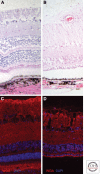Gene therapy using stem cells
- PMID: 25395375
- PMCID: PMC4382729
- DOI: 10.1101/cshperspect.a017434
Gene therapy using stem cells
Abstract
Viral-mediated gene augmentation therapy has recently shown success in restoring vision to patients with retinal degenerative disorders. Key to this success was the availability of animal models that accurately presented the human phenotype to test preclinical efficacy and safety. These exciting studies support the use of gene therapy in the treatment of devastating retinal degenerative diseases. In some cases, however, in vivo gene therapy for retinal degeneration would not be effective because the cell types targeted are no longer present. The development of somatic cell reprogramming methods provides an attractive source of autologous cells for transplantation and treatment of retinal degenerative disease. This article explores the development of gene therapy and patient-derived stem cells for the purpose of restoring vision to individuals suffering from inherited retinal degenerations.
Copyright © 2015 Cold Spring Harbor Laboratory Press; all rights reserved.
Figures



References
-
- Acland GM, Aguirre GD, Ray J, Zhang Q, Aleman TS, Cideciyan AV, Pearce-Kelling SE, Anand V, Zeng Y, Maguire AM, et al. 2001. Gene therapy restores vision in a canine model of childhood blindness. Nat Genet 28: 92–95. - PubMed
-
- Acland GM, Aguirre GD, Bennett J, Aleman TS, Cideciyan AV, Bennicelli J, Dejneka NS, Pearce-Kelling SE, Maguire AM, Palczewski K, et al. 2005. Long-term restoration of rod and cone vision by single dose rAAV-mediated gene transfer to the retina in a canine model of childhood blindness. Mol Ther 12: 1072–1082. - PMC - PubMed
-
- Bainbridge JWB, Smith AJ, Barker SS, Robbie S, Henderson R, Balaggan K, Viswanathan A, Holder GE, Stockman A, Tyler N, et al. 2008. Effect of gene therapy on visual function in Leber’s congenital amaurosis. N Engl J Med 358: 2231–2239. - PubMed
-
- Balaggan KS, Ali RR 2012. Ocular gene delivery using lentiviral vectors. Gene Ther 19: 145–153. - PubMed
Publication types
MeSH terms
Grants and funding
LinkOut - more resources
Full Text Sources
Other Literature Sources
Medical
